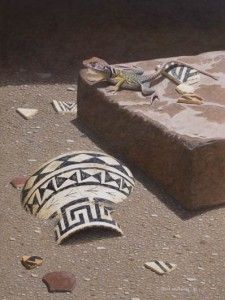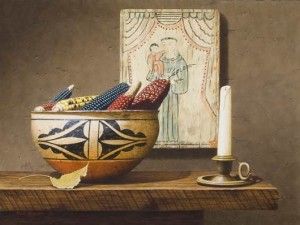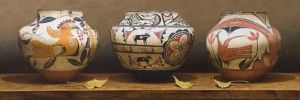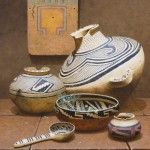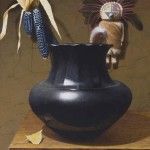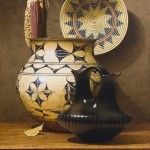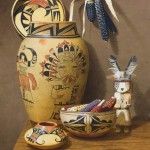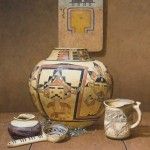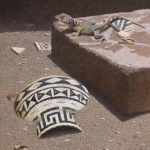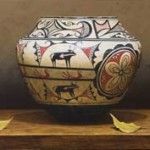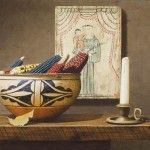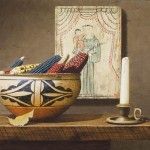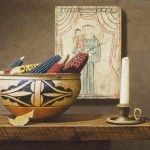By Norman Kolpas
Rock and Cody Newcomb and a visiting friend were exploring Homolovi Ruins State Park, north of Winslow, AZ, where about 2,000 ancestors of the Hopi tribe lived seven centuries ago. As the three of them picked their way through an excavated pueblo’s rooms, moving carefully to avoid stepping on shards of ancient pots, a large, collared lizard followed the trio like a shy but friendly dog. From time to time, Newcomb raised his camera to train his lens on a patterned piece of pottery, capturing it on film from four or five different angles.
Each such Indian artifact “has its own character, its own history, an intrinsic beauty that reflects its time and its culture,” says Newcomb, explaining the passion for such objects of the past that inspire him to create painstakingly detailed acrylic still-life paintings of them. “A hundred or 200 years from now, I want people to know what these things really looked like.”
But Newcomb’s paintings go beyond mere faithful reproduction. Each is a singular composition that brings together real objects from different sources, different times, and different tribes in juxtapositions that resonate with each other not only visually but also spiritually. In the process, their meaning is amplified, touching and enlightening viewers. In effect, a Newcomb painting becomes a unique museum exhibit that exists only on the clayboard surface on which it is rendered—and in the viewer’s mind.
Take those Homolovi shards and that amiable reptile, for instance. They all found their way into a work Newcomb titled ECHOES OF THE PAST, the pottery pieces jutting up while the lizard surveys the scene “like the guardian of the ruins,” says the artist. The focal point of the painting, however, is an Anasazi pitcher decorated with geometric patterns inspired by turkey tracks, butterflies, and rattlesnake skin.
Like all the objects Newcomb portrays, that pitcher is real. But he can’t divulge where he photographed it. Many of the artifacts he paints are, in fact, held in private collections or in the archive vaults of universities, museums, foundations, or corporations. Over the years, Newcomb has gained access to them thanks to his growing reputation and to the charming persuasive powers of his wife, Cody, who serves as his business manager. “She is the hunter,” he laughs. “And I come in for the kill.”
William Rockford Newcomb has followed his passions for both art and Indian artifacts for most of his 65 years. It took just a few decades, however, for the two to mesh into a professional career that has won him numerous awards and accolades over the past decade-plus.
He was born in a military hospital in Oakland, CA, in the waning days of World War II, while his dad, William Boyd Newcomb, served as an Air Force belly gunner. After the war, the family moved to his dad’s hometown of Cambridge, NE, where young Rocky lived until the age of 9. That’s when his father entered a veterans’ drawing for homesteads in southern Idaho and drew a 160-acre plot in the arid, mountain-ringed desert of Magic Valley in southern Idaho.
“It was like dying and going to hell,” Newcomb recalls dryly. “Our plot was covered with sagebrush and rocks and rabbits and coyotes. At first, we had no running water, and in the dark of night I’d have to go out and carry five-gallon buckets of water, thinking I was going to be eaten alive. At five in the morning and six in the evening, I was milking 16 to 20 head of cows. In retrospect, it was probably one of the best upbringings any kid could have had. I learned what hard work really was.”
Newcomb also quickly developed a fascination for Indian artifacts. “That part of Idaho is a prime location for arrowhead hunting. I was finding obsidian artifacts 10,000 years old.”
He also continued to develop a talent for drawing that had revealed itself from the time he was young enough to hold a crayon. “Back in Nebraska, my grandmother, who was the local librarian, encouraged me to draw,” he says. “I’d do drawings of Indians and trout and bass and jet airplanes.” But at the county high school in Minidoka, ID, he never took an art class. “There was one elective or sports.”
When he entered junior college in Fullerton, CA, he planned to become an architect. A life-drawing class was a prerequisite for that course of study, and, Newcomb recalls, “I rediscovered that I had the knack.” He switched majors and pursued a degree in art at Cal State Fullerton.
In his senior year, however, it dawned on him that he “could starve to death going out and just being an artist.” Design and illustration work didn’t appeal: “I really didn’t want to do art by committee.” Instead, after graduation he earned his teaching credentials and found work teaching art and English at Fullerton Union High.
Teaching was Newcomb’s life for the next three decades. He taught in Southern California for many years, then in Idaho, and then back in California. He taught while earning a master’s degree in art, through fatherhood to two sons, through divorce and then marriage to Cody, his high-school sweetheart.
All the while Newcomb painted in his spare time, selling oils and watercolors of wildlife, figures, portraits, and American Indians. “I’d get home every day at four o’clock and paint until midnight,” he says. Meanwhile, he and Cody “saved every nickel and dime we made through the art, banking it as a backup for going full-time some day.”
That day finally came in June 1997, when Newcomb was teaching at Carlsbad High School north of San Diego. As the end of the school year approached, he walked into the principal’s office. “I don’t think I’m gonna be back next year,” he recalls saying. “I’m going to try art full time.” The principal sat silent, staring at him. Finally, he asked, “What took you so long?”
The Newcombs left for Jackson, WY, where he was the artist-in-residence for several months at Astoria Fine Art. En route back to California, he and Cody stopped to visit friends in Payson, AZ, fell in love with the small community, and decided to move there. “It’s dead square in the middle of the state, at 5,000 feet,” he says. “We get all four seasons. We also have the largest ponderosa pine forest in the world and the largest concentration of black bear—along with elk, deer, and javelina. I feel like we moved to Mayberry, R.F.D.”
In that idyllic setting, he continues, “my subject matter started changing immediately. I started seeing all these beautiful subjects in prehistoric and historic Native American artifacts.” Thus began the series of paintings for which Newcomb is now so widely known and honored.
At their home in Payson, Newcomb has happily settled into a routine characterized by the work ethic first instilled in him on the Idaho homestead. In the small studio off his house, he paints seven days a week, from nine o’clock in the morning until half past midnight, breaking only for meals.
He begins a work with reference prints of the photos he shot, finding a pleasing combination and composition of objects, and then sketches them in pencil on vellum. Next, he copies the drawing directly onto clayboard, a commercial piece of Masonite panel covered in smooth, absorbent, archival-quality white clay that provides the ideal surface for the acrylic paints he now prefers. He lays in dark colors first. “The grabber in a painting is the design, and the first thing a person notices are the dark and light values. I like to see a variety of strong values,” he explains.
Lastly comes his trademark wealth of infinitesimal detail. “In my painting PUEBLO CEREMONIES, the basket alone took about a week,” he says. “On every single ribbing, the shadow constantly changes as you go around. And in LEGACY OF THE PLAINS, each bead on the moccasins and hanging bag has its own perspective. Some artists just take a pointed brush and put dots all across. But I paint each one, and not only do they get shorter as they go around, but they also become different colors as they go into shadow.”
To discerning collectors and curators, such details matter. And Newcomb, a full-time artist at last, is more than happy to provide them, reveling in the tranquility and beauty of his home, hunting down rare Indian artifacts with the help of his beloved wife, and painting what he wants to paint the way he wants to paint it. He feels he has finally fulfilled his true calling. “Here in Payson,” he says, “I’ve basically died and gone to heaven.”
Norman Kolpas is a Los Angeles-based freelancer who writes for Mountain Living and Colorado Homes & Lifestyles as well as Southwest Art.
Dossier Representation
Astoria Fine Art, Jackson, WY; Hueys Fine Art, Santa Fe, NM; Lovetts
Gallery, Tulsa, OK; J. Willott Gallery, Palm Desert, CA.
Upcoming Shows
Quest for the West, Eiteljorg Museum, Indianapolis, IN, through October 10.
Group show, National Museum of Wildlife Art, Jackson, WY, through October 31.
Featured in October 2010






